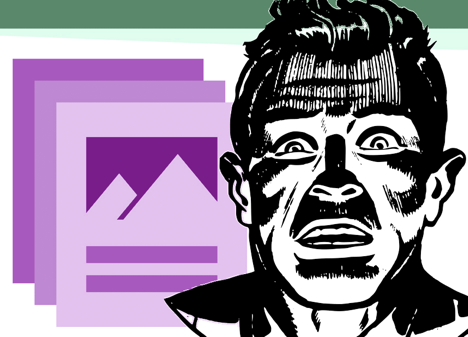In studying the art and science of UX design, it’s easy to find guidance and leadership in the form of technical studies: how to create a deliverable or why one tool is better than another. This makes sense because UX professionals need to understand the technical underpinnings of the craft, while remaining up-to-date on how to approach and solve problems.
We also find much that is written about why UX design is important; numerous books and articles which have paved the way for a shared understanding, and a vocabulary which helps persuade and influence project stakeholders.
Foundational documents such as these have helped to define a practice where none existed just a few years back. They provide the pillars of our professional identity.
Yet in our day-to-day life within our organizations, it is possible–even likely–that you fight many of the same battles year in and year out. You want to be an agent of change and an evangelist for UX principles, but you find that the path forward is far from linear. There’s not as much guidance that tells you exactly how to tilt the balance in your favor. You know you need to change hearts and minds, but how?
What can you do about it?
The answer to this is not in further enhancement of your technical abilities, nor in refining your justifications. The answer is in providing UX leadership within your organization. You have to provide a framework for people outside your UX practice to easily understand what you do and why you do it.
The first step in this journey is to write your UX playbook, and I’m going to help you by explaining exactly what that means, and how to do it.
Let’s go shopping
Every one of us from beginner to expert provides products and services to a market. Whether you’re a Walmart or a Nordstrom, your customers need a catalog of what you offer and how much it will cost them. So a playbook is a catalog, right?
Umm, yes… but a good catalog is much more than a listing of products. Think of boring catalogs you receive in your mailbox with nothing but items and prices. If you’re like me, you throw those away without looking at them, unless you already know what you want. In other words, a simple cataloging of items and prices doesn’t really address value, so its persuasiveness is limited.
You’re hoping to get people excited about your team and what you offer. You need to help non-UX people understand the value you bring, and what you do all day. You’re trying to change behaviors, promote design thinking and build UX maturity within your organization, and this will take a bit more than a simple list of products and prices.
A UX playbook… what is it?
At its core, a UX playbook is a living document that contains the entirety of UX solutions your team brings to the table. It describes the deliverables, the processes, and the workflows that define what you do every single day.
It also needs to include what should be done–yet often isn’t.
For instance, maybe you find that your organization doesn’t do a lot of usability testing, for all the classic reasons. Does that mean you should leave it out?
Absolutely not, in fact the opposite is true. You must include it even if it feels aspirational for the time-being. Remember, you’re not only describing an as-is state, but also an ideal state. You’re trying to move an immovable object in a positive direction, and the UX playbook is the lever that can make that happen.
To be effective, your playbook needs to open up minds. It should spark thought while reflecting and enhancing the cultural values of your organization.
My personal belief is that we should apply user-centered design principles to almost everything we do. In this case, design for who the audience is. What are their motivations? Their thoughts and beliefs?
Too many UX professionals think that the quality of the work speaks for itself. This isn’t true, you always need to package and sell it.
Balance your users’ cognitive and emotional states against your main objectives. Do you see how taking your organization’s cultural values into account provides powerful context for your message? This is how you increase the likelihood of success: always think of your users first in everything you do.
Time to get cooking
I create two versions of the UX Playbook. One is a high-level version which I call the Executive Edition. This version needs to cut to the chase with pictures, bullet points, and short sentences. As the name implies, the Executive Edition is intended for an audience above your pay grade.
The second version, or complete playbook is much more in-depth. This edition would (hopefully) be of interest to most of the people reading this article; and it would probably bore non-UX people to tears.
The complete playbook is good for aligning teams, might be appropriate for some stakeholders, and is a great onboarding tool. It also provides justification for what you do, and can help you advance professionally.
Executive content
The executive playbook begins with an executive summary or overview, followed by a UX process diagram. The executive summary should be no more than a few bullets, and the process diagram should show your UX phases and how they fit into your company’s overall digital development process.
Defining your UX process to this executive audience is important because your ability to clearly articulate a process gives you credibility. Processes quantify activities, imply a lower risk, and facilitate things like repeatability and scalability. Your UX process is part of your organization’s intellectual property, so fly that flag high and proud.
My UX process breaks down into the following phases:
- Research
- Strategy
- Prototyping
- Validation
Setting the stage, I now go into the four sections which correspond to the above phases. Each section contains a few pages that describe typical deliverables. On those pages for each deliverable, I include the following:
- Name
- Image
- Description
- Value (or problem it solves)
- Level of Effort (you can approximate this by saying small, medium, or large)
Finally, for the Executive playbook, I pare down the UX offerings to 3-4 of the most typical for each phase. In other words, it’s not exhaustive. I know I said earlier that your playbook should be an aspirational model, but if no one reads it, its efficacy is limited.
Expanded content
The full edition, or your complete UX playbook will follow a similar format, but will have more meat on the bones. It’s a comprehensive cataloging of all possible UX deliverables, both the as-is and the ideal state.
The full playbook features detailed descriptions and much more: things like the current situation, desired outcomes, expectations inputs and outputs, and so on. You’ll find as you start writing that you have a lot of internalized knowledge that you may have never put down on the page. Be creative, this is your playbook.
In your intro, I still recommend providing an overview, but allow yourself to discuss your topic with a little more detail. Include a hyperlinked table of contents to allow your readers to skip around if they desire.
Here are some expanded introductory ideas that I include in my full version:
- What is UX?
- What is the team’s role/responsibility within organization?
- Expanded explanations of both phases and individual activities
- Desired outcome/expectations
- Benefits and value for everything you and your team do
Finally, and most important
Introduce the team.
It’s crucial to put names and faces on this flurry of activity. All of us are proud of what we do, and part of your job as a UX leader is to promote the hopes and dreams–as well as the careers–of your teammates.
Include contact information and encourage people to reach out to anyone on the team. This humanizes UX, and positions your team as partners to help evangelize UX and provide thought leadership. As you certainly know, UX is a group activity, most effective when the channels of communication are open and collaboration is encouraged.
That’s it!
It’s no great mystery. As I said up front, I don’t think I’ve seen as much on this topic as on other more technical topics, so I hope this guide will be useful to you. Use my content bullets as your outline, and just start filling in the blanks. Getting started is probably the hardest part.
If you want to read further, I highly recommend the UX Playbook by Deborah S. Biggar as well as UX Strategy by Jaime Levy. Both of these books were indispensable in helping me to understand the bigger picture and formulate many of the ideas I’ve presented here.
As always, please post your comments or questions below and I’ll do my best to answer them.
Good luck writing your playbook!
____________________
Sources:
Biggar, Deborah S. UX Playbook: the Guide to Defining User Experience in Your Organization. Publisher Not Identified, 2016.
Levy, Jaime. UX Strategy How to Devise Innovative Digital Products That People Want. O’Reilly, 2015.



